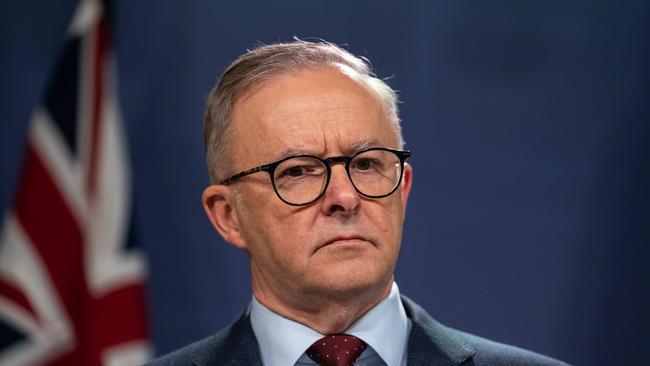Albanese’s choice: budgetary prudence or broken promise poison pill
Labor won’t go anywhere near junking the agreed tax cuts, worried about the political risks of breaking election commitments and introducing big picture policies after the disastrous 2019 loss.

Labor helped legislate them after initially opposing them and at this year’s election promised not to repeal the tax cuts. But the new government’s left flank and many in the centre are demanding the government shift position and repeal the cuts. Why? In the name of fiscal prudence and fairness.
But even those arguments aren’t that simple in policy terms, and that’s before getting to the political risks attached to breaking election commitments.
The upper echelons of the Labor government don’t regard a backflip as likely. They would rather cop the criticism of retaining the cuts than wear the odium of a broken promise.
The income tax cuts work like this: they will reduce the 32.5 per cent tax rate to 30 per cent and abolish the 37 per cent tax rate altogether, leaving anyone earning $45,000 to $200,000 (or above) paying 30c in the dollar tax on that quotient of their income.
The current 32.5 per cent tax bracket applies to earning from $45,000 to $120,000. It will be scrapped, as will the 37 per cent bracket for incomes of $120,000 to $180,000. The top threshold of 45c in the dollar tax will increase from $180,000 to $200,000 as part of the stage three changes.
Australians earning $200,000 or more a year therefore will receive a tax cut of slightly more than $9000 each year. That is substantial in anyone’s language.
The reason many feel that stage three is unfair is because someone earning half that amount receives a cut of less than $1500. In other words, the stage three income tax cuts are geared unashamedly towards those earning well above $100,000.
Complicating any defence of the sizeable tax cut for those earning $200,000 or more is the fact parliamentary backbenchers and government ministers just happen to earn above that figure.
Everyone from the Australian Council of Social Service to the unions and the Greens is up in arms about the looming cuts, and with the Newstart allowance staying the same it’s not hard to see why. But Labor was asked point blank at the election if it would repeal the stage three cuts and it said point blank no, it wouldn’t – words senior Labor figures have echoed ever since.
Which brings us to John Maynard Keynes: when the facts change, I change my mind; what do you do? Have the facts changed? Perhaps.
The budget is in a far worse position than it was when the three-staged tax cuts were first articulated back in 2018. At that time the Coalition was standing by the delusion that it would balance the budget and start delivering an endless stream of surpluses to pay down debt. Instead debt is ticking towards $1 trillion and no surplus projection is in sight.
Interestingly, when you crunch the data the benefit to the budget bottom line of not proceeding with the abolition of the 37c tax bracket is minimal; it’s the downgrading of the 32.5c bracket to 30c that punches the bigger hole in the budget. That’s because too few Australians earn enough to be affected by the 37c bracket.
I suspect opposition to cutting the 32.5c bracket to 30c for those earning $45,000 to $120,000 is minimal; it’s the tax cut for higher-income earners that is politically fraught. But denying them a cut (remembering stages one and two cuts lower down the income tax line have already been enacted) isn’t the one with the more extreme fiscal hit.
Even if Labor could find a way politically to swallow the poison pill left for it and repeal the cuts, what happened to the notion that Australia is too reliant on income taxes rather than wealth or consumption taxes? Repealing the stage three tax cuts would only exacerbate that concerning reality.
The problem is that the stage three cuts were announced and legislated in isolation of wider tax reform, which is overdue. So they embed unfairness in the system and put strain on revenue. Had they been legislated in conjunction with new and innovative wealth taxes, for example, the cuts would be harder to criticise on policy grounds.
But courtesy of the 2019 election loss Labor shied away from such ideas, promising not to introduce things such as capital gains tax reform and adjustments to negative gearing if it won this year’s election.
So here we are. What is the way out of this mess? It won’t be easy. All Labor can probably do is stick by the stage three income tax cuts but hold a tax summit this term (as opposed to its meaningless skills summit) and take wholesale tax reform to the next election, and after a serious debate about what the size of government should be and what citizens expect from their government.
Government services cost money. The welfare state has grown exponentially since its arrival in the 20th century, but it has turned our democracy into the sort of society most Australians want it to be. With the challenges of an ageing population alongside the desire to expand the welfare state to protect the most vulnerable (think National Disability Insurance Scheme) the fiscal strains on the budget are set to grow, not shrink, in the coming decades.
We need a serious debate about reform and what it looks like. It has to be holistic and it must recognise the unsustainable parts of the system that need changing.
The only alternative Labor has at its disposal is to break its election promise, which risks all manner of unintended consequences, or be a do-nothing administration and kick the reforming can further down the road.
Advocates for junking stage three claim because most voters don’t benefit from the cuts, repealing the laws won’t be the political hit it otherwise might be. But most voters weren’t affected by the franking credits policy Bill Shorten took to the 2019 election either. It didn’t prevent a scare campaign convincing those unaffected that they would be impacted by the policy.
Untruthful scare campaigns have become a feature of Australian elections. The Mediscare campaign Labor mounted against Malcolm Turnbull in 2016 was false but it almost returned Labor to office after one parliamentary term. The 2019 Coalition scare campaign on death duties frightened voters even though it wasn’t part of Labor’s platform.
Peter Dutton strikes me as the sort of chap who would do quite well mounting a scare campaign against Labor for breaking promises and putting up taxes. And it wouldn’t be a false construct if that’s what Labor chose to do. Tony Abbott didn’t do a bad job throwing Julia Gillard’s emissions trading scheme back in her face after her 2010 election campaign promise that “there will be no carbon tax under a government I lead”.
Peter van Onselen is a professor of politics and public policy at the University of Western Australia and Griffith University.




The stage three income tax cuts – already legislated but not due to take effect until 2024 – are the ultimate political poison pill for the Labor government.